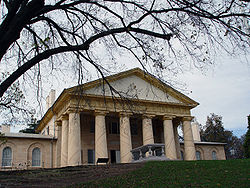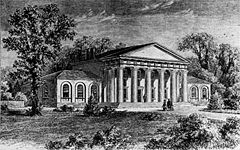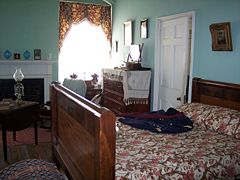- Arlington House, The Robert E. Lee Memorial
-
Arlington House, The Robert E. Lee Memorial
Location: Arlington, Virginia, USA Coordinates: 38°52′52.2″N 77°4′21.54″W / 38.881167°N 77.07265°WCoordinates: 38°52′52.2″N 77°4′21.54″W / 38.881167°N 77.07265°W Area: 1,100 acres (450 ha) Built: 1803 Architect: George Hadfield Architectural style: Greek Revival Visitation: 627,576[1] (2010) Governing body: National Park Service NRHP Reference#: 66000040 Added to NRHP: October 15, 1966[2][3] Arlington House, The Robert E. Lee Memorial, formerly named the Custis-Lee Mansion,[4][5] is a Greek revival style mansion located in Arlington, Virginia, USA that was once the home of Confederate General Robert E. Lee. It overlooks the Potomac River, directly across from the National Mall in Washington, D.C. During the American Civil War, the grounds of the mansion were selected as the site of Arlington National Cemetery, in part to ensure that Lee would never again be able to return to his home. However, the United States has since designated the mansion as a National Memorial to Lee, a mark of widespread respect for him in both the North and South.
Contents
Construction and early history
The mansion was built on the orders of George Washington Parke Custis, a step-grandson and adopted son of George Washington. Custis was a prominent resident of what was then known as Alexandria County, at the time a part of the District of Columbia.
Arlington House was built on an 1,100 acre (445 ha) estate, originally purchased by Custis' father, John Parke Custis, in 1778.[6] George Washington Parke Custis decided to build his home on the property in 1802, following the death of Martha Washington and three years after the death of George Washington. Custis originally wanted to name the property "Mount Washington", but was persuaded by family members to name it "Arlington House" after the Custis family's homestead on the Eastern Shore of Virginia.[7]
George Hadfield, an English architect who also worked on the design of the United States Capitol, designed the mansion. The north and south wings were completed between 1802 and 1804. The large center section and the portico, presenting an imposing front 140 ft (43 m) long, were finished 13 years later. The house has two kitchens, a summer and a winter. The most prominent features of the house are the 8 massive columns of the portico, each 5 feet (1.5 m) in diameter.
Custis was a prominent resident of the jurisdiction that was then named Alexandria County and is now named Arlington County. Guests at the house included such notable people as Gilbert du Motier, marquis de La Fayette, who visited in 1824. At Arlington, Custis experimented with new methods of animal husbandry and other agriculture. The property also included Arlington Spring, a picnic ground on the banks of the Potomac that Custis originally built for private use but later opened to the public, eventually operating it as a commercial enterprise.
Custis married Mary Lee Fitzhugh. Their only child to survive to adulthood was Mary Anna Randolph Custis. Robert E. Lee, whose mother was a cousin of Mrs. Custis, frequently visited Arlington and knew Mary Anna as they grew up. Two years after graduating from West Point, Lieutenant Lee married Mary Anna Custis at Arlington on June 30, 1831. For 30 years Arlington House was home to the Lees. They spent much of their married life traveling between U.S. Army duty stations and Arlington, where six of their seven children were born. They shared this home with Mary's parents. After their deaths, Mary's parents were buried not far from the house on land that is now part of Arlington National Cemetery.
Upon George Washington Parke Custis' death in 1857, he left the Arlington estate to Mary Custis Lee for her lifetime and thence to the Lee's eldest son, George Washington Custis Lee. The estate needed much repair and reorganization, and Gen. Lee, as executor of Custis' will, took a leave of absence from the Army until 1860 to begin the necessary agricultural and financial improvements.
Civil War
One month after the American Civil War began with the Battle of Fort Sumter on April 12–13, 1861, citizens of the Commonwealth of Virginia ratified by popular vote on May 23 the Commonwealth's articles of secession, essentially finalizing the Commonwealth's separation from the Union (see: Secession in the United States and Virginia in the American Civil War).[8] On the day after secession, Robert E. Lee, who at that time was a colonel who had served in the United States Army for 35 years, was offered command of the Union Army by Francis Preston Blair during a visit to Washington. Lee had disapproved of secession, but decided that he could not fight against Virginia, his native state. Instead of accepting the Union command, he resigned his commission in the Army in a letter written at Arlington House on April 20. Within days of his resignation, Lee reported to Richmond for the duty of commanding Virginia's Provisional Army. He joined the Confederate States Army with Virginia's forces a month later and was promoted to general. Lee was concerned for the safety of his wife, who was still residing at the mansion and convinced her to vacate the property, at least temporarily. She managed to send many of the family's valuables off to safety, as she had advance notice of the impending Union occupation from her cousin, Orton W. Williams. Robert E. Lee never set foot on the property again, but shortly before her 1873 death, Mary Anna Custis Lee visited her Arlington once more.[9]
The Union Army occupied the Arlington estate soon after the Lees left their property, whereupon Arlington House became the headquarters of the Union's Army of Northeastern Virginia (see: Army of the Potomac) under Brigadier General Irvin McDowell. Many of the George Washington heirlooms that George Washington Parke Custis had collected were eventually moved to the Patent Office for safekeeping. Some items, however, including a few of the Mount Vernon heirlooms, were looted and scattered by Union soldiers living in or visiting the house. In 1864, the federal government of the United States confiscated the house and property because the property's owner, Mary Anna Custis Lee, had not paid her property tax in person.[10][11]
By 1864, the military cemeteries of Washington and Alexandria were filled with Union dead, and Quartermaster General Montgomery C. Meigs quickly selected Arlington as the site for a new cemetery. Meigs, a Georgian who had served under Lee in the U.S. Army and who considered that Lee had made a treasonous decision to fight against the Union, ordered the burial of 26 Union soldiers in Mrs. Lee's prized rose garden. In October, Meigs' own son was killed in the war, and was later buried at Arlington alongside his mother and father.
Post-Civil War
After his surrender on April 9, 1865, to Union Army Lieutenant General Ulysses S. Grant at the McLean House in the village of Appomattox Court House, Virgina (see: Appomattox Court House National Historical Park), Robert E. Lee and his wife chose not to contest the federal government's seizure of their home, apparently because Lee felt that it would be too divisive. In 1870, after his father's death, the Lee's eldest son, George Washington Custis Lee (who had earlier been a Major General in the Confederate Army (see: General officers in the Confederate States Army)), filed a lawsuit against the United States government in the Alexandria Circuit Court to regain his property. In 1882, the Supreme Court of the United States finally ruled on the case in a 5-4 decision (United States v. Lee, 106 U. S. 196 (1882)).[10][11] The court found that the estate had been 'illegally confiscated' in 1864 and ordered it returned, along with 1,100 acres (4 km2) of surrounding property. In its decision, the court cited as precedential a similar case that it had decided in 1870 (Bennett v. Hunter (76 U.S. (9 Wall.) 326 (1870)) that had involved the nearby Abingdon estate.[12][13][14] In 1883, Custis Lee sold the mansion and property to the U.S. government for $150,000 (roughly equal to $3.5 million in 2011 dollars) at a signing ceremony with Secretary of War, Robert Todd Lincoln.[15]
In 1920, the Virginia General Assembly renamed Alexandria County as Arlington County, to honor Robert E. Lee and to end the ongoing confusion between Alexandria County and the independent city of Alexandria.
The mansion and some 28 acres around it are managed by the National Park Service as a memorial to Robert E. Lee. The grounds, flower garden, and kitchen garden are Colonial Revival in style. The land surrounding the mansion, over half of the original plantation's 1,100 acres, and known as Arlington National Cemetery, is managed by the Department of the Army.
Arlington House suffered moderate damage in the 2011 Virginia earthquake, requiring the closure of the back halls and upper floor pending an architectural assessment.[16]
Replicas
In 1919 a replica was built for the short-lived Lanier University in Atlanta, designed by architect A. Ten Eyck Brown. It is still standing at 1140 University Drive NE, housing the Canterbury School. Arlington Hall, in Dallas's Lee Park, is a two-thirds scale replica of Arlington House.
Notes
- ^ "Five Year Annual Recreation Visits Report". Public Use Statistic Office, National Park Service. http://www.nature.nps.gov/stats/viewReport.cfm?selectedReport=SystemComparisonReport.cfm.
- ^ "National Register of Historic Places: NPS Focus". National Park Service. http://nrhp.focus.nps.gov. Retrieved 2011-08-22.
- ^ Seagraves, Anna; Fuqua, Ann; Veloz, Nicholas, George Washington Memorial Parkway, National Capital Region, National Park Service (1980-01-15). "Arlington House, The Robert E. Lee Memorial". United States Department of the Interior: National Park Service: National Register of Historic Places — Nomination Form for Federal Properties. National Park Service. http://pdfhost.focus.nps.gov/docs/NRHP/Text/66000040.pdf. Retrieved 2011-08-22.
- ^ Patterson, Michael Robert (2004-12-14). "Arlington House (The Custis-Lee Mansion)". Arlington National Cemetery website. http://www.arlingtoncemetery.net/arlhouse.htm. Retrieved 2011-08-22.
- ^ "Today in History: May 13: Arlington National Cemetery". American Memory. Library of Congress. http://lcweb2.loc.gov/ammem/today/may13.html. Retrieved 2011-080-22.
- ^ Peters, p. 3
- ^ Peters, p. 5
- ^ Virginia Historical Society
- ^ "Mary Anna Randolph Custis Lee". Arlington House, The Robert E. Lee Memorial. United States National Park Service, United States Department of the Interior. 2007-96-19. http://www.nps.gov/arho/historyculture/mary-lee.htm. Retrieved 2011-08-22.
- ^ a b Wikisource: United States v. Lee Kaufman
- ^ a b Desty, Robert, ed (1883). "United States v. Lee; Kaufman and another v. Same, December 4, 1882 (106 U.S. 196)". Supreme Court Reporter. Cases Argued and Determined in the United States Supreme Court, October Term, 1882: October, 1882-February, 1883 (Saint Paul, MN: West Publishing Company) 1: 240–286. http://books.google.com/books?id=9U03AAAAIAAJ. Retrieved 2011-08-22.
- ^ Wikisource: Bennett v. Hunter
- ^ Wallace, John William (1870). "Bennett v. Hunter". Cases argued and adjudged in the Supreme Court of the United States, December Term, 1869 (Washington, D.C.: William H. Morrison) 9: 326–338. http://books.google.com/books?id=QL0GAAAAYAAJ. Retrieved 2011-08-22.
- ^ Ashmore, Anne (August 2006). "Dates of Supreme Court Decisions and Arguments: United States Reports: Volumes 2 — 107 (1791-1882)". Washington, D.C.: Library, Supreme Court of the United States. p. 96. http://www.supremecourt.gov/opinions/datesofdecisions.pdf. Retrieved 2011-08-22.
- ^ "Arlington House". Historical Information. Arlington, Virginia: Arlington National Cemetery. http://www.arlingtoncemetery.org/historical_information/arlington_house.html. Retrieved 2011-08-22.
- ^ "Arlington House, The Robert E. Lee Memorial." National Park Service. August 30, 2011. Accessed 2011-09-26.
References
- Peters, James Edward (1986). Arlington National Cemetery: Shrine to America's Heroes. Woodbine House. ISBN 1890627143.
- The National Parks: Index 2001-2003. Washington: U.S. Department of the Interior.
External links
- Official website: "Arlington House, The Robert E. Lee Memorial". National Park Service. http://www.nps.gov/arho/index.htm. Retrieved 2011-08-22.
- Horton, James Oliver. "The Future of Slavery's Historical Spaces". Southern Spaces, February 16, 2009, http://southernspaces.org/2009/future-slaverys-historical-spaces.
Third generation Fourth generation Fifth generation Elizabeth Parke Custis Law • Martha Parke Custis Peter • Eleanor Parke Custis Lewis • George Washington Parke CustisSixth generation Custis family residences: Abingdon • Arlington House • Ravensworth • Thomas Law House • Tudor Place • White HouseThe Washington family First generation Lawrence Washington (1602–1653)Second generation Third generation Lawrence Washington (1659–1698)Fourth generation Fifth generation Lawrence Washington (1718–1752) • Augustine Washington, Jr. • George Washington • Betty Washington Lewis • Samuel Washington • John Augustine Washington • Charles WashingtonSixth generation Seventh generation John Thornton Augustine Washington • George Corbin WashingtonEighth generation Ninth generation George Corbin Washington • James Barroll Washington • Mary Ann Washington • Eliza Ridgeley Washington • Betty Lewis Washington • William De Hertbrun WashingtonTenth generation William Lanier WashingtonWashington family residences: Abingdon • Arlington House • Beall-Air • Blakeley • Cedar Lawn • Claymont Court • Ferry Farm • George Washington Birthplace National Monument • Happy Retreat • Harewood • Kenmore • Mary Washington House • Mount Vernon • Richwood Hall • Ridgedale • Rising Sun Tavern • River Farm • Sulgrave • Washington Old HallU.S. National Register of Historic Places Topics Lists by states Alabama • Alaska • Arizona • Arkansas • California • Colorado • Connecticut • Delaware • Florida • Georgia • Hawaii • Idaho • Illinois • Indiana • Iowa • Kansas • Kentucky • Louisiana • Maine • Maryland • Massachusetts • Michigan • Minnesota • Mississippi • Missouri • Montana • Nebraska • Nevada • New Hampshire • New Jersey • New Mexico • New York • North Carolina • North Dakota • Ohio • Oklahoma • Oregon • Pennsylvania • Rhode Island • South Carolina • South Dakota • Tennessee • Texas • Utah • Vermont • Virginia • Washington • West Virginia • Wisconsin • WyomingLists by territories Lists by associated states Other Categories:- National Memorials of the United States
- Arlington National Cemetery
- Arlington County Historic Districts
- Washington family residences
- Lee family residences
- Historic house museums in Virginia
- Custis family residences
- Plantations in Virginia
- Protected areas established in 1925
- Museums in Arlington County, Virginia
- Fitzhugh family of Virginia
- Biographical museums in Virginia
- United States National Park Service areas in Virginia
- Greek Revival architecture in Virginia
- Houses on the National Register of Historic Places in Virginia
- Houses in Arlington County, Virginia
Wikimedia Foundation. 2010.




